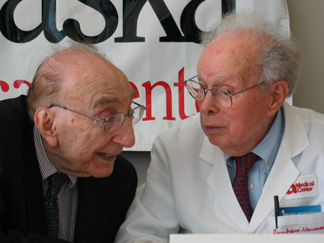 |
Denham Harman, M.D., Ph.D., right, talks with world-renowned surgeon Michael DeBakey, M.D., in 2005. Dr. Harman is being honored this week by the European aging network, LINK-AGE, at a symposium in Portugal. |
Dr. Harman, 91, Emeritus Millard Professor of Medicine, is known internationally as the father of the Free Radical Theory of Aging, which he proposed in 1954.
The theory is one of the most well-known and respected theories on the aging process.
“I’m delighted they did this,” Dr. Harman said of the symposium tribute. “I’ve worked on this for a long time. This is a useful theory that in essence says we’re not going to live forever. Right now, life expectancy in America is about 85 years. Few reach 100 and even fewer more than that. It’s a hard fact.”
|
|
By minimizing copper, iron and other oxidant catalysts, antioxidants can decrease the rate of aging and of disease pathogenesis. Many studies now support this possibility.
“We decided to honor Dr. Harman because much of the research we do and the scientific interest we follow, exists largely because of his seminal paper in 1956 on the Free Radical Theory of Aging and his continuous intervention thereafter,” said Henrique de Almeida, M.D., Ph.D., symposium organizer and associate professor, University of Porto in Portugal. “Though the theory has not been proven, it provides a mechanistic/chemical explanation having strong experimental support and has been the framework for the build up of sound and useful science to us all.”
Dr. Harman discovered the theory while working as a research associate at the Donner Laboratory of Medical Physics at the University of California, Berkeley. Years later in mouse models in the laboratory, Dr. Harman employed antioxidants such as vitamins E, C and beta carotene to reduce the cancer-causing and atherosclerosis-causing effects of free radicals.
His work has produced insights into potential means to delay age-related conditions and most recently has turned to mechanisms involved in Alzheimer’s disease.
Dr. Harman’s theory laid the groundwork for a great deal of research and interest in the aging process, and the discovery of the potential of antioxidants to fight off cancer, heart disease and other degenerative effects of aging.
“What I’ve learned in all this business is we have so many years and we need to make the best of it,” Dr. Harman said. “Mother Nature designed this wonderful thing and she designed it so we don’t live forever. It’s something you can’t beat. Maybe I’m wrong but I don’t think so.”